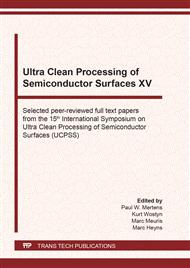p.167
p.172
p.181
p.186
p.192
p.197
p.202
p.209
p.214
Simulation of Rayleigh Bubble Growth near a No-Slip Rigid Wall
Abstract:
In order to study the role of growing cavitation bubbles in the context of ultrasonic cleaning, we perform two-dimensional, axisymmetric Navier-Stokes simulation for compressible, multicomponent flow and examine the so-called Rayleigh growth of an air bubble (with initial radius 33 µm and pressure 10 MPa) near a rigid wall. The simulation suggests that strong shear stress, which is important in physical cleaning such as particle removal, appears as a result of the bubble-growth-induced shock passage. The parametric study with varying a standoff distance of the bubble to the wall shows that the wall shear stress linearly decreases against the standoff distance.
Info:
Periodical:
Pages:
192-196
Citation:
Online since:
February 2021
Authors:
Permissions:
Share:
Citation:


